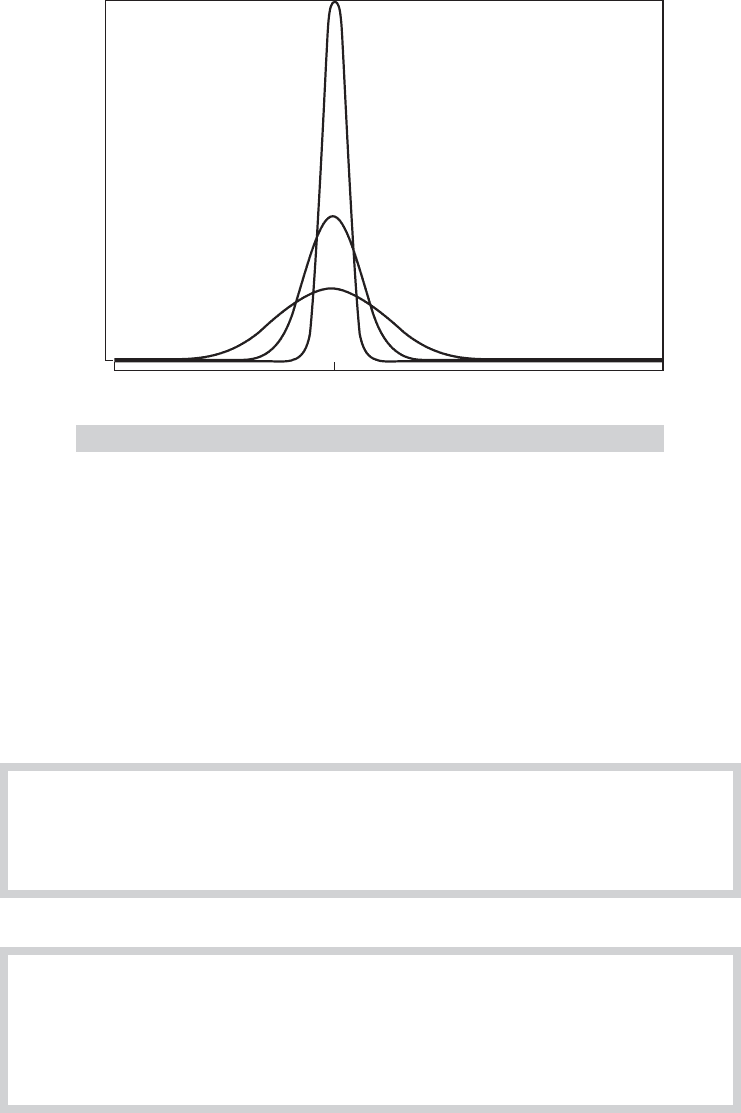Greene W.H. Econometric Analysis
Подождите немного. Документ загружается.


APPENDIX D
✦
Large-Sample Distribution Theory
1069
n 10
n 100
Estimator
Density
n 1000
FIGURE D.1
Quadratic Convergence to a Constant,
θ
.
Convergence in probability does not imply convergence in mean square. Consider the simple
example given earlier in which x
n
equals either zero or n with probabilities 1 − (1/n) and (1/n).
The exact expected value of x
n
is 1 for all n, which is not the probability limit. Indeed, if we let
Prob(x
n
= n
2
) = (1/n) instead, the mean of the distribution explodes, but the probability limit is
still zero. Again, the point x
n
= n
2
becomes ever more extreme but, at the same time, becomes
ever less likely.
The conditions for convergence in mean square are usually easier to verify than those for
the more general form. Fortunately, we shall rarely encounter circumstances in which it will be
necessary to show convergence in probability in which we cannot rely upon convergence in mean
square. Our most frequent use of this concept will be in formulating consistent estimators.
DEFINITION D.2
Consistent Estimator
An estimator
ˆ
θ
n
of a parameter θ is a consistent estimator of θ if and only if
plim
ˆ
θ
n
= θ. (D-4)
THEOREM D.4
Consistency of the Sample Mean
The mean of a random sample from any population with finite mean μ and finite variance
σ
2
is a consistent estimator of μ.
Proof: E[¯x
n
] = μ and Var[ ¯x
n
] = σ
2
/n. Therefore, ¯x
n
converges in mean square to μ,or
plim ¯x
n
= μ.

1070
PART VI
✦
Appendices
Theorem D.4 is broader than it might appear at first.
COROLLARY TO THEOREM D.4
Consistency of a Mean
of Functions
In random sampling, for any function g(x),ifE[g(x)] and Var[g(x)] are finite constants,
then
plim
1
n
n
i=1
g(x
i
) = E[g(x)]. (D-5)
Proof: Define y
i
= g(x
i
) and use Theorem D.4.
Example D.2 Estimating a Function of the Mean
In sampling from a normal distribution with mean μ and variance 1, E [e
x
] = e
μ+1/2
and
Var [e
x
] = e
2μ+2
− e
2μ+1
. (See Section B.4.4 on the lognormal distribution.) Hence,
plim
1
n
n
i =1
e
x
i
= e
μ+1/2
.
D.2.2 OTHER FORMS OF CONVERGENCE AND LAWS
OF LARGE NUMBERS
Theorem D.4 and the corollary just given are particularly narrow forms of a set of results known
as laws of large numbers that are fundamental to the theory of parameter estimation. Laws of
large numbers come in two forms depending on the type of convergence considered. The simpler
of these are “weak laws of large numbers” which rely on convergence in probability as we defined
it above. “Strong laws” rely on a broader type of convergence called almost sure convergence.
Overall, the law of large numbers is a statement about the behavior of an average of a large
number of random variables.
THEOREM D.5
Khinchine’s Weak Law of Large Numbers
If x
i
, i = 1,...,n is a random (i.i.d.) sample from a distribution with finite mean E [x
i
] = μ,
then
plim ¯x
n
= μ.
Proofs of this and the theorem below are fairly intricate. Rao (1973) provides one.
Notice that this is already broader than Theorem D.4, as it does not require that the variance of
the distribution be finite. On the other hand, it is not broad enough, because most of the situations
we encounter where we will need a result such as this will not involve i.i.d. random sampling. A
broader result is

APPENDIX D
✦
Large-Sample Distribution Theory
1071
THEOREM D.6
Chebychev’s Weak Law of Large Numbers
If x
i
, i = 1,...,n is a sample of observations such that E [x
i
] = μ
i
< ∞ and Var[x
i
] =
σ
2
i
< ∞ such that ¯σ
2
n
/n = (1/n
2
)
i
σ
2
i
→ 0 as n →∞, then plim( ¯x
n
− ¯μ
n
) = 0.
There is a subtle distinction between these two theorems that you should notice. The Chebychev
theorem does not state that ¯x
n
converges to ¯μ
n
, or even that it converges to a constant at all.
That would require a precise statement about the behavior of ¯μ
n
. The theorem states that as
n increases without bound, these two quantities will be arbitrarily close to each other—that
is, the difference between them converges to a constant, zero. This is an important notion
that enters the derivation when we consider statistics that converge to random variables, in-
stead of to constants. What we do have with these two theorems are extremely broad condi-
tions under which a sample mean will converge in probability to its population counterpart.
The more important difference between the Khinchine and Chebychev theorems is that the
second allows for heterogeneity in the distributions of the random variables that enter
the mean.
In analyzing time-series data, the sequence of outcomes is itself viewed as a random event.
Consider, then, the sample mean, ¯x
n
. The preceding results concern the behavior of this statistic
as n →∞for a particular realization of the sequence ¯x
1
,..., ¯x
n
. But, if the sequence, itself, is
viewed as a random event, then limit to which ¯x
n
converges may be also. The stronger notion of
almost sure convergence relates to this possibility.
DEFINITION D.3
Almost Sure Convergence
The random variable x
n
converges almost surely to the constant c if and only if
Prob
lim
n→∞
x
n
= c
= 1.
This is denoted x
n
a.s.
−→ c. It states that the probability of observing a sequence that does not
converge to c ultimately vanishes. Intuitively, it states that once the sequence x
n
becomes close
to c, it stays close to c.
Almost sure convergence is used in a stronger form of the law of large numbers:
THEOREM D.7
Kolmogorov’s Strong Law of Large Numbers
If x
i
, i = 1,...,n is a sequence of independently distributed random variables such that
E [x
i
] = μ
i
< ∞ and Var[x
i
] = σ
2
i
< ∞ such that
∞
i=1
σ
2
i
/i
2
< ∞ as n →∞then
¯x
n
− ¯μ
n
a.s.
−→ 0.

1072
PART VI
✦
Appendices
THEOREM D.8
Markov’s Strong Law of Large Numbers
If {z
i
}is a sequence of independent random variables with E[z
i
] = μ
i
< ∞and if for some
δ>0,
∞
i=1
E[|z
i
− μ
i
|
1+δ
]/i
1+δ
< ∞, then ¯z
n
− ¯μ
n
converges almost surely to 0, which
we denote ¯z
n
− ¯μ
n
a.s.
−→ 0.
2
The variance condition is satisfied if every variance in the sequence is finite, but this is not strictly
required; it only requires that the variances in the sequence increase at a slow enough rate that
the sequence of variances as defined is bounded. The theorem allows for heterogeneity in the
means and variances. If we return to the conditions of the Khinchine theorem, i.i.d. sampling, we
have a corollary:
COROLLARY TO THEOREM D.8
(Kolmogorov)
If x
i
, i = 1,...,n is a sequence of independent and identically distributed random variables
such that E[x
i
] = μ<∞ and E[|x
i
|] < ∞, then ¯x
n
− μ
a.s.
−→ 0.
Note that the corollary requires identically distributed observations while the theorem only
requires independence. Finally, another form of convergence encountered in the analysis of time-
series data is convergence in rth mean:
DEFINITION D.4
Convergence in rth Mean
If x
n
is a sequence of random variables such that E[|x
n
|
r
] < ∞and lim
n→∞
E[|x
n
−c|
r
] = 0,
then x
n
converges in rth mean to c. This is denoted x
n
r.m.
−→ c.
Surely the most common application is the one we met earlier, convergence in means square,
which is convergence in the second mean. Some useful results follow from this definition:
THEOREM D.9
Convergence in Lower Powers
If x
n
converges in rth mean to c, then x
n
converges in sth mean to c for any s < r . The
proof uses Jensen’s Inequality, Theorem D.13. Write E[|x
n
− c|
s
] = E[(|x
n
− c|
r
)
s/r
] ≤
E[(|x
n
− c|
r
)]
s/r
and the inner term converges to zero so the full function must also.
2
The use of the expected absolute deviation differs a bit from the expected squared deviation that we have
used heretofore to characterize the spread of a distribution. Consider two examples. If z ∼ N[0,σ
2
], then
E[|z|] = Prob[z < 0]E[−z | z < 0] + Prob[z ≥ 0]E[z |z ≥ 0] = 0.7979σ . (See Theorem 18.2.) So, finite
expected absolute value is the same as finite second moment for the normal distribution. But if z takes values
[0, n] with probabilities [1 − 1/n, 1/n], then the variance of z is (n − 1), but E[|z − μ
z
|]is2− 2/n.For
this case, finite expected absolute value occurs without finite expected second moment. These are different
characterizations of the spread of the distribution.

APPENDIX D
✦
Large-Sample Distribution Theory
1073
THEOREM D.10
Generalized Chebychev’s Inequality
If x
n
is a random variable and c is a constant such that with E[|x
n
− c|
r
] < ∞ and ε is a
positive constant, then Prob(|x
n
− c| >ε)≤ E[|x
n
− c|
r
]/ε
r
.
We have considered two cases of this result already, when r = 1 which is the Markov inequality,
Theorem D.3, and when r = 2, which is the Chebychev inequality we looked at first in Theo-
rem D.2.
THEOREM D.11
Convergence in rth mean and Convergence
in Probability
If x
n
r.m.
−→ c, for some r > 0, then x
n
p
−→ c. The proof relies on Theorem D.10. By
assumption, lim
n→∞
E [|x
n
−c|
r
] = 0 so for some n sufficiently large, E [|x
n
−c|
r
] < ∞.
By Theorem D.10, then, Prob(|x
n
−c|>ε)≤ E [|x
n
−c|
r
]/ε
r
for any ε>0. The denomina-
tor of the fraction is a fixed constant and the numerator converges to zero by our initial
assumption, so lim
n→∞
Prob(|x
n
−c|>ε)=0, which completes the proof.
One implication of Theorem D.11 is that although convergence in mean square is a convenient
way to prove convergence in probability, it is actually stronger than necessary, as we get the same
result for any positive r.
Finally, we note that we have now shown that both almost sure convergence and convergence
in r th mean are stronger than convergence in probability; each implies the latter. But they,
themselves, are different notions of convergence, and neither implies the other.
DEFINITION D.5
Convergence of a Random Vector or Matrix
Let x
n
denote a random vector and X
n
a random matrix, and c and C denote a vector
and matrix of constants with the same dimensions as x
n
and X
n
, respectively. All of the
preceding notions of convergence can be extended to (x
n
, c) and (X
n
, C) by applying the
results to the respective corresponding elements.
D.2.3 CONVERGENCE OF FUNCTIONS
A particularly convenient result is the following.
THEOREM D.12
Slutsky Theorem
For a continuous function g(x
n
) that is not a function of n,
plim g(x
n
) = g(plim x
n
). (D-6)
The generalization of Theorem D.12 to a function of several random variables is direct, as
illustrated in the next example.

1074
PART VI
✦
Appendices
Example D.3 Probability Limit of a Function of
¯
¯
xand
s
2
In random sampling from a population with mean μ and variance σ
2
, the exact expected
value of ¯x
2
n
/s
2
n
will be difficult, if not impossible, to derive. But, by the Slutsky theorem,
plim
¯x
2
n
s
2
n
=
μ
2
σ
2
.
An application that highlights the difference between expectation and probability is suggested
by the following useful relationships.
THEOREM D.13
Inequalities for Expectations
Jensen’s Inequality. If g(x
n
) is a concave function of x
n
, then g
E [x
n
]
≥ E [g(x
n
)].
Cauchy–Schwarz Inequality. For two random variables,
E [|xy|] ≤
E [x
2
]
1/2
E [y
2
]
1/2
.
Although the expected value of a function of x
n
may not equal the function of the expected
value—it exceeds it if the function is concave—the probability limit of the function is equal to
the function of the probability limit.
The Slutsky theorem highlights a comparison between the expectation of a random variable
and its probability limit. Theorem D.12 extends directly in two important directions. First, though
stated in terms of convergence in probability, the same set of results applies to convergence in
rth mean and almost sure convergence. Second, so long as the functions are continuous, the
Slutsky theorem can be extended to vector or matrix valued functions of random scalars, vectors,
or matrices. The following describe some specific applications. Some implications of the Slutsky
theorem are now summarized.
THEOREM D.14
Rules for Probability Limits
If x
n
and y
n
are random variables with plim x
n
= c and plim y
n
= d, then
plim(x
n
+ y
n
) = c + d,(sum rule) (D-7)
plim x
n
y
n
= cd,(product rule) (D-8)
plim x
n
/y
n
= c/d if d = 0.(ratio rule) (D-9)
If W
n
is a matrix whose elements are random variables and if plim W
n
= , then
plim W
−1
n
=
−1
.(matrix inverse rule) (D-10)
If X
n
and Y
n
are random matrices with plim X
n
= A and plim Y
n
= B, then
plim X
n
Y
n
= AB.(matrix product rule) (D-11)
D.2.4 CONVERGENCE TO A RANDOM VARIABLE
The preceding has dealt with conditions under which a random variable converges to a constant,
for example, the way that a sample mean converges to the population mean. To develop a theory

APPENDIX D
✦
Large-Sample Distribution Theory
1075
for the behavior of estimators, as a prelude to the discussion of limiting distributions, we now
consider cases in which a random variable converges not to a constant, but to another random
variable. These results will actually subsume those in the preceding section, as a constant may
always be viewed as a degenerate random variable, that is one with zero variance.
DEFINITION D.6
Convergence in Probability to a Random
Variable
The random variable x
n
converges in probability to the random variable x if
lim
n→∞
Prob(|x
n
− x| >ε)= 0 for any positive ε.
As before, we write plim x
n
= x to denote this case. The interpretation (at least the intuition) of
this type of convergence is different when x is a random variable. The notion of closeness defined
here relates not to the concentration of the mass of the probability mechanism generating x
n
at a
point c, but to the closeness of that probability mechanism to that of x. One can think of this as
a convergence of the CDF of x
n
to that of x.
DEFINITION D.7
Almost Sure Convergence to a Random Variable
The random variable x
n
converges almost surely to the random variable x if and only if
lim
n→∞
Prob(|x
i
− x| >εfor all i ≥ n) = 0 for all ε>0.
DEFINITION D.8
Convergence in rth Mean to a Random Variable
The random variable x
n
converges in rth mean to the random variable x if and only if
lim
n→∞
E [|x
n
− x|
r
] = 0. This is labeled x
n
r.m.
−→ x. As before, the case r = 2 is labeled
convergence in mean square.
Once again, we have to revise our understanding of convergence when convergence is to a random
variable.
THEOREM D.15
Convergence of Moments
Suppose x
n
r.m.
−→ x and E [|x|
r
] is finite. Then, lim
n→∞
E [|x
n
|
r
] = E [|x|
r
].
Theorem D.15 raises an interesting question. Suppose we let r grow, and suppose that x
n
r.m.
−→ x
and, in addition, all moments are finite. If this holds for any r, do we conclude that these random
variables have the same distribution? The answer to this longstanding problem in probability
theory—the problem of the sequence of moments—is no. The sequence of moments does not
uniquely determine the distribution. Although convergence in rth mean and almost surely still
both imply convergence in probability, it remains true, even with convergence to a random variable
instead of a constant, that these are different forms of convergence.

1076
PART VI
✦
Appendices
D.2.5 CONVERGENCE IN DISTRIBUTION:
LIMITING DISTRIBUTIONS
A second form of convergence is convergence in distribution. Let x
n
be a sequence of random
variables indexed by the sample size, and assume that x
n
has cdf F
n
(x
n
).
DEFINITION D.9
Convergence in Distribution
x
n
converges in distribution to a random variable x with CDF F(x) if
lim
n→∞
| F
n
(x
n
) − F(x)|=0 at all continuity points of F(x).
This statement is about the probability distribution associated with x
n
; it does not imply that
x
n
converges at all. To take a trivial example, suppose that the exact distribution of the random
variable x
n
is
Prob(x
n
= 1) =
1
2
+
1
n + 1
, Prob(x
n
= 2) =
1
2
−
1
n + 1
.
As n increases without bound, the two probabilities converge to
1
2
, but x
n
does not converge to a
constant.
DEFINITION D.10
Limiting Distribution
If x
n
converges in distribution to x, where F
n
(x
n
) is the CDF of x
n
, then F(x) is the limiting
distribution of x
n
. This is written
x
n
d
−→ x.
The limiting distribution is often given in terms of the pdf, or simply the parametric family. For
example, “the limiting distribution of x
n
is standard normal.”
Convergence in distribution can be extended to random vectors and matrices, although not
in the element by element manner that we extended the earlier convergence forms. The reason is
that convergence in distribution is a property of the CDF of the random variable, not the variable
itself. Thus, we can obtain a convergence result analogous to that in Definition D.9 for vectors or
matrices by applying definition to the joint CDF for the elements of the vector or matrices. Thus,
x
n
d
−→ x if lim
n→∞
|F
n
(x
n
) − F(x)|=0 and likewise for a random matrix.
Example D.4 Limiting Distribution of t
n
−
1
Consider a sample of size n from a standard normal distribution. A familiar inference problem
is the test of the hypothesis that the population mean is zero. The test statistic usually used
is the t statistic:
t
n−1
=
¯x
n
s
n
/
√
n
,
where
s
2
n
=
n
i =1
( x
i
− ¯x
n
)
2
n − 1
.

APPENDIX D
✦
Large-Sample Distribution Theory
1077
The exact distribution of the random variable t
n−1
is t with n − 1 degrees of freedom. The
density is different for every n:
f ( t
n−1
) =
( n/2)
[( n − 1)/2]
[(n − 1) π]
−1/2
1 +
t
2
n−1
n − 1
−n/2
, (D-12)
as is the CDF, F
n−1
(t) =
&
t
−∞
f
n−1
( x) dx. This distribution has mean zero and variance (n −1)/
(n − 3) . As n grows to infinity, t
n−1
converges to the standard normal, which is written
t
n−1
d
−→ N[0, 1].
DEFINITION D.11
Limiting Mean and Variance
The limiting mean and variance of a random variable are the mean and variance of the
limiting distribution, assuming that the limiting distribution and its moments exist.
For the random variable with t[n] distribution, the exact mean and variance are zero and
n/(n − 2), whereas the limiting mean and variance are zero and one. The example might suggest
that the limiting mean and variance are zero and one; that is, that the moments of the limiting
distribution are the ordinary limits of the moments of the finite sample distributions. This situation
is almost always true, but it need not be. It is possible to construct examples in which the exact
moments do not even exist, even though the moments of the limiting distribution are well defined.
3
Even in such cases, we can usually derive the mean and variance of the limiting distribution.
Limiting distributions, like probability limits, can greatly simplify the analysis of a problem.
Some results that combine the two concepts are as follows.
4
THEOREM D.16
Rules for Limiting Distributions
1. If x
n
d
−→ x and plim y
n
= c, then
x
n
y
n
d
−→ cx, (D-13)
which means that the limiting distribution of x
n
y
n
is the distribution of cx. Also,
x
n
+ y
n
d
−→ x + c, (D-14)
x
n
/y
n
d
−→ x/c, if c = 0. (D-15)
2. If x
n
d
−→ x and g(x
n
) is a continuous function, then
g(x
n
)
d
−→ g(x). (D-16)
This result is analogous to the Slutsky theorem for probability limits. For
an example, consider the t
n
random variable discussed earlier. The exact distribu-
tion of t
2
n
is F[1, n]. But as n −→ ∞ , t
n
converges to a standard normal variable.
According to this result, the limiting distribution of t
2
n
will be that of the square of a
standard normal, which is chi-squared with one
3
See, for example, Maddala (1977a, p. 150).
4
For proofs and further discussion, see, for example, Greenberg and Webster (1983).

1078
PART VI
✦
Appendices
THEOREM D.16
(Continued)
degree of freedom. We conclude, therefore, that
F[1, n]
d
−→ chi-squared[1]. (D-17)
We encountered this result in our earlier discussion of limiting forms of the standard
normal family of distributions.
3. If y
n
has a limiting distribution and plim (x
n
− y
n
) = 0, then x
n
has the same limiting
distribution as y
n
.
The third result in Theorem D.16 combines convergence in distribution and in probability. The
second result can be extended to vectors and matrices.
Example D.5 The F Distribution
Suppose that t
1,n
and t
2,n
are a K × 1 and an M × 1 random vector of variables whose
components are independent with each distributed as t with n degrees of freedom. Then, as
we saw in the preceding, for any component in either random vector, the limiting distribution
is standard normal, so for the entire vector, t
j,n
d
−→ z
j
, a vector of independent standard
normally distributed variables. The results so far show that
(t
1,n
t
1,n
)/K
(t
2,n
t
2,n
)/M
d
−→ F [K, M].
Finally, a specific case of result 2 in Theorem D.16 produces a tool known as the Cram´er–Wold
device.
THEOREM D.17
Cramer–Wold Device
If x
n
d
−→ x, then c
x
n
d
−→ c
x for all conformable vectors c with real valued elements.
By allowing c to be a vector with just a one in a particular position and zeros elsewhere, we see
that convergence in distribution of a random vector x
n
to x does imply that each component does
likewise.
D.2.6 CENTRAL LIMIT THEOREMS
We are ultimately interested in finding a way to describe the statistical properties of estimators
when their exact distributions are unknown. The concepts of consistency and convergence in
probability are important. But the theory of limiting distributions given earlier is not yet adequate.
We rarely deal with estimators that are not consistent for something, though perhaps not always
the parameter we are trying to estimate. As such,
if plim
ˆ
θ
n
= θ, then
ˆ
θ
n
d
−→ θ.
That is, the limiting distribution of
ˆ
θ
n
is a spike. This is not very informative, nor is it at all what
we have in mind when we speak of the statistical properties of an estimator. (To endow our finite
sample estimator
ˆ
θ
n
with the zero sampling variance of the spike at θ would be optimistic in the
extreme.)
As an intermediate step, then, to a more reasonable description of the statistical properties
of an estimator, we use a stabilizing transformation of the random variable to one that does have
